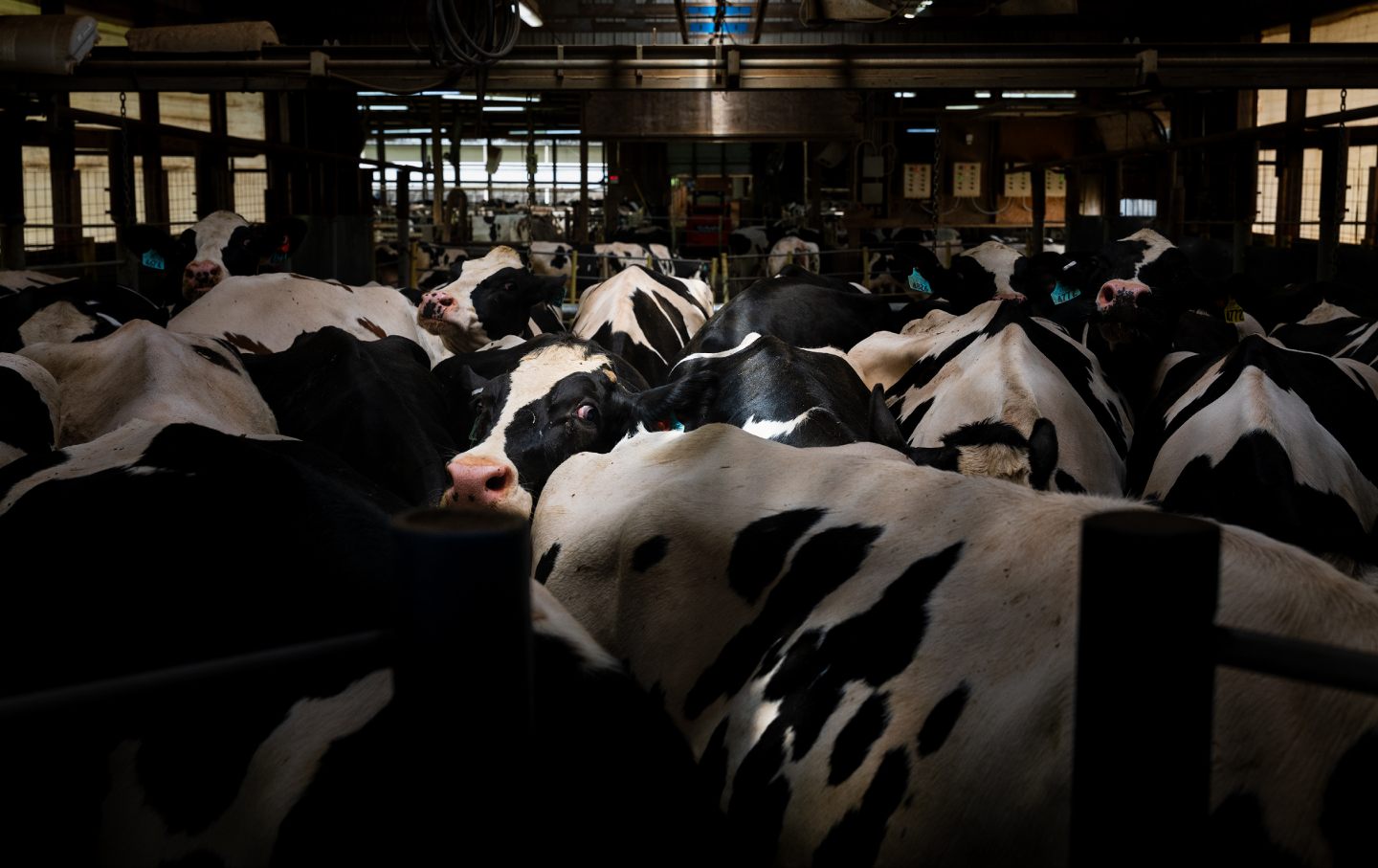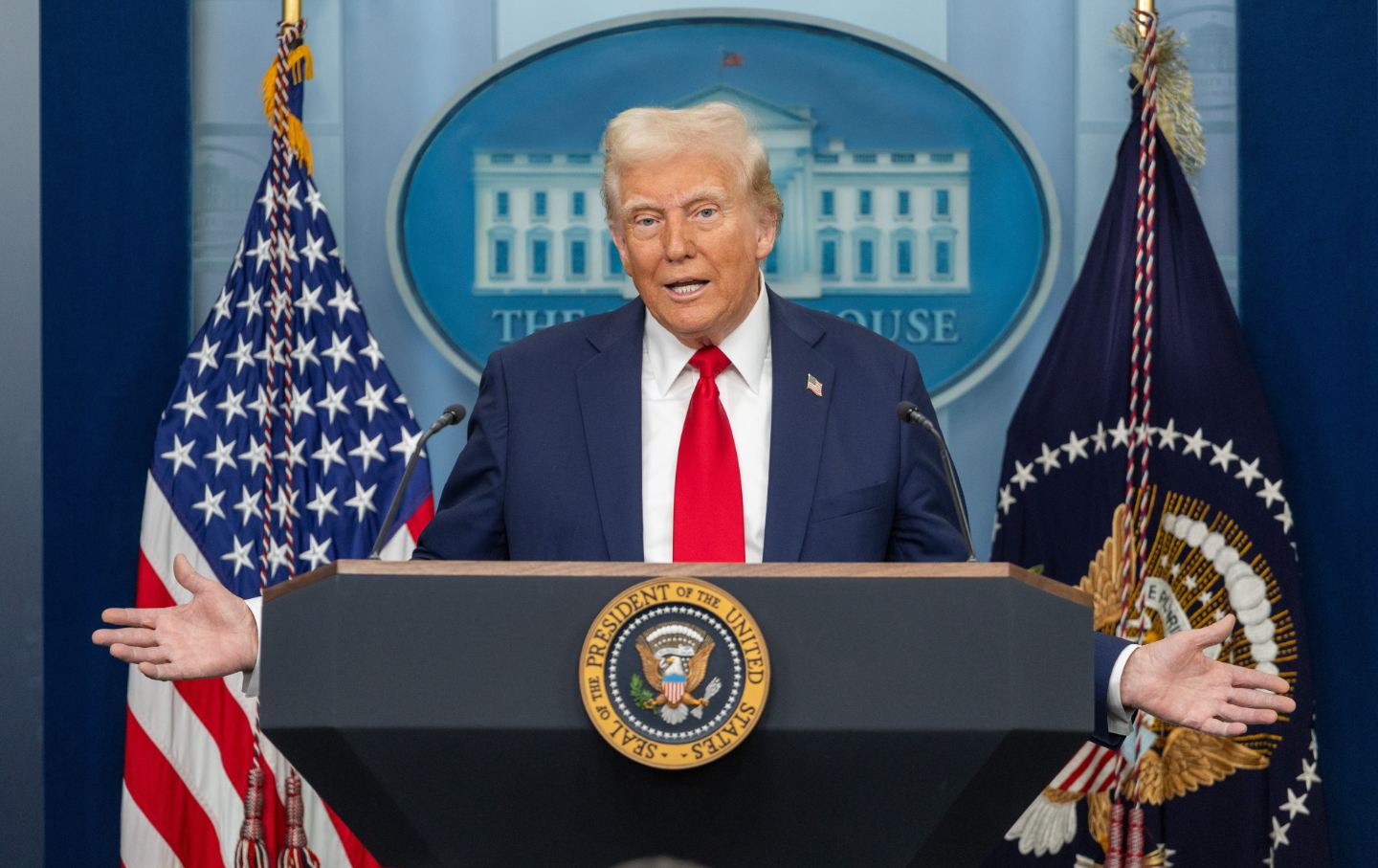We’re Facing a Potential Bird Flu Catastrophe
H5N1 is spreading across the US, targeting some of our most vulnerable communities, and exposing our tattered public health system. We need bold action, and we need it now.

Cows queuing for milking at United Dreams Dairy, in North Freedom, Wisconsin, on May 8, 2024.
(Matthew Ludak / The Washington Post via Getty Images)Whether it was wealthy Londoners fleeing to the countryside to avoid the bubonic plague in the early 17th century or Manhattanites heading for upstate and seaside retreats to do the same to avoid SARS-CoV-2 in the early 21st, urban elites have rarely stuck around for pandemics. As Troy Tassier says in his new book The Rich Flee and the Poor Take the Bus, “the most physical and financial harm from epidemics falls upon the people who are least privileged and most marginalized,” while those with the most resources seek out the best security and safety money can buy.
Yet the notion of rural communities as refuges from disease, then and now, doesn’t match up with reality. Those rich Londoners brought the plague with them to the small villages and hamlets nearby, and, far from their being a safe haven, the mortality rate from Covid was 20 percent higher in rural America than in urban enclaves. This misconception is grounded in a refusal to recognize that, rather than an unspoiled oasis, our rural counties are home to some of our most marginalized populations, from the meat and poultry workers that keep us fed to the upstate prisons where cities lock up those they would rather ignore and forget. The virus raced through these areas, amplifying the pandemic across the landscape with deadly consequences.
Everything that made rural America uniquely vulnerable to Covid-19 still exists. And now, a new threat from a well-known pathogen, influenza, is brewing in America’s rural heartland. An outbreak of H5N1 started months ago and is spreading across dairy farms in the United States. This strain of bird flu looks like it is “well entrenched and has been in cattle for a long time and…probably very, very, very widespread,” as Stat News reported. While there are only two documented human cases thus far, given the poor surveillance effort to date, there are likely other people infected as well.
While this strain of H5N1 has not (yet) acquired the ability to spread through the air or person to person, the virus presents potentially serious health risks to those who work with cattle on dairy operations in rural areas. The vast majority of those working on the front lines are immigrants, many of them undocumented. Anthropologist Thurka Sangaramoorthy has talked about the precarity of the lives of these workers, from not having “rights within the workspace, not having access to good housing or being really scared to speak up when they’re being exploited or when they feel like they’re being discriminated against.”
Agricultural workers also face an increasingly threadbare rural health system that is ill-equipped to respond to their needs. Over the past 30 years, rural America has lost hospitals, primary care providers, and public health infrastructure. Many farmworkers lack insurance and have tenuous connections to healthcare and other services. Without robust health systems and formal safety nets, many farmworkers and their families turn to “Band-Aid care”—as in “Putting Band-Aids on Things That Need Stitches”—rather than care that would help them over the long term.
Now add a new pathogen into the mix. We know the US public health system is weak, social protections are inadequate, and healthcare is tilted towards expensive, tertiary, specialized practices. Rural America is ground zero for this structural, human-made disaster, which makes rural farming communities desperately vulnerable to H5N1. For all the bluster of the current response to H5N1, with the CDC, the FDA, and the USDA all out with their plans to address the virus and its spread, no one is acknowledging that a crisis already existed in these places.
Dealing with this new outbreak will undoubtedly expose the long-standing political failures to address the public health needs of these communities. “Band-Aid” care is no match for H5N1 if it acquires the mutations it needs to transmit efficiently among humans. And if the outbreak takes off in these settings, there is simply no firewall to stop it from making the trip from its rural origins into the rest of the country.
The instinct of those in Atlanta or DC is to deal with the current emergency and ignore the rest—except that is not how the world works. We tried it with Covid in the US, and the fundamental weaknesses in American public health, welfare, and healthcare ensured that we did worse than our G-7 peers in Covid deaths and excess deaths per capita. H5N1 is not (yet) a human epidemic, but the widespread nature of its grip on livestock in rural communities means it gets to bide its time.
As with Covid-19, we are offering false assurances with the ubiquitous refrain of “we have the tools,” suggesting that a technical fix, the mere existence of vaccines, tests, and treatments for influenza, will be our salvation. Yet, we know that this is a vastly insufficient response. We still have the time to address structural issues plaguing rural America, to give those living in rural agricultural counties and the rest of us, a leg up on H5N1, though it’s admittedly a race against the clock and would require a massive investment of resources and political will.
There are signs that President Biden and Congress want to invest in rural America to lift up economic opportunity. But investing in rural health is vital to these economic strategies; they must go hand in hand. There are encouraging moves here as well, but we need something akin to a Marshall Plan for rural America—and there might be bipartisan support for such bold efforts, particularly in health.
Finally, the revival and survival of rural America depends on immigrants—over 70 percent of farmworkers are foreign-born—and so the economic and health initiatives we surely need will be for naught unless we safeguard the future of these workers and their families from xenophobic policies from county seats, state houses and from DC.
H5N1 reminds us that when it comes to infectious diseases, there is no place to hide, no refuge or safety, except what we build together, systems and infrastructures to protect all of us. Perhaps this time around, we’ll do better and chalk up a victory against an old foe.
Time is running out to have your gift matched
In this time of unrelenting, often unprecedented cruelty and lawlessness, I’m grateful for Nation readers like you.
So many of you have taken to the streets, organized in your neighborhood and with your union, and showed up at the ballot box to vote for progressive candidates. You’re proving that it is possible—to paraphrase the legendary Patti Smith—to redeem the work of the fools running our government.
And as we head into 2026, I promise that The Nation will fight like never before for justice, humanity, and dignity in these United States.
At a time when most news organizations are either cutting budgets or cozying up to Trump by bringing in right-wing propagandists, The Nation’s writers, editors, copy editors, fact-checkers, and illustrators confront head-on the administration’s deadly abuses of power, blatant corruption, and deconstruction of both government and civil society.
We couldn’t do this crucial work without you.
Through the end of the year, a generous donor is matching all donations to The Nation’s independent journalism up to $75,000. But the end of the year is now only days away.
Time is running out to have your gift doubled. Don’t wait—donate now to ensure that our newsroom has the full $150,000 to start the new year.
Another world really is possible. Together, we can and will win it!
Love and Solidarity,
John Nichols
Executive Editor, The Nation
More from The Nation

Read the CBS Report Bari Weiss Doesn’t Want You to See Read the CBS Report Bari Weiss Doesn’t Want You to See
A transcript of the 60 Minutes segment on CECOT, the notorious prison in El Salvador.

The Christmas Narrative Is About Charity and Love, Not Greed and Self-Dealing The Christmas Narrative Is About Charity and Love, Not Greed and Self-Dealing
John Fugelsang and Pope Leo XIV remind us that Christian nationalism and capitalism get in the way of the message of the season.

In Memoriam: Beautiful Writers, Influential Editors, Committed Activists In Memoriam: Beautiful Writers, Influential Editors, Committed Activists
A tribute to Nation family we lost this year—from Jules Feiffer to Joshua Clover, Elizabeth Pochoda, Bill Moyers, and Peter and Cora Weiss

Trump’s Anti-DEI Crusade Is Going to Hit White Men, Too Trump’s Anti-DEI Crusade Is Going to Hit White Men, Too
Under the Trump administration’s anti-DEI directives, colleges would be forced to abandon gender balancing, disadvantaging men.

Why We Need Kin: A Conversation With Sophie Lucido Johnson Why We Need Kin: A Conversation With Sophie Lucido Johnson
The author and cartoonist explains why we should dismantle the nuclear family and build something bigger.

Bari Weiss’s Counter-Journalistic Crusade Targets “60 Minutes” Bari Weiss’s Counter-Journalistic Crusade Targets “60 Minutes”
The new editor in chief at CBS News has shown she’s not merely stupendously unqualified—she’s ideologically opposed to the practice of good journalism.


